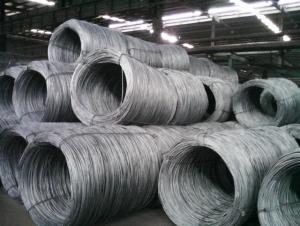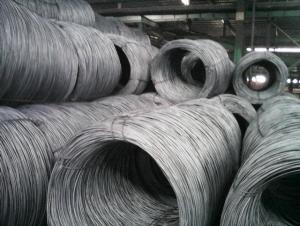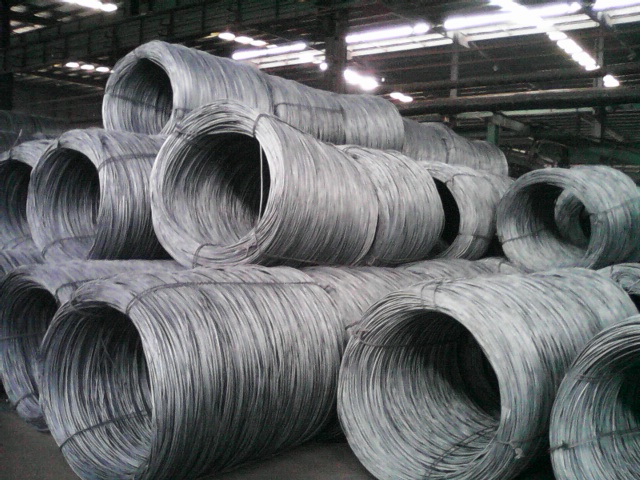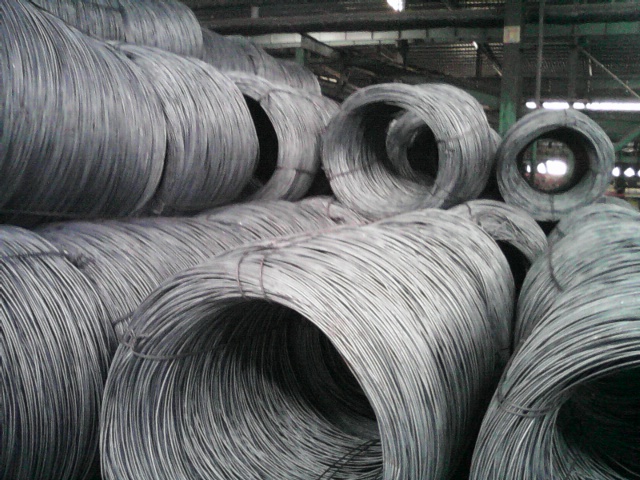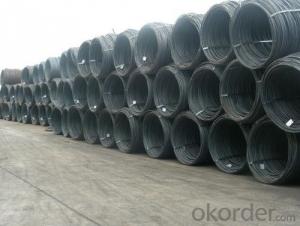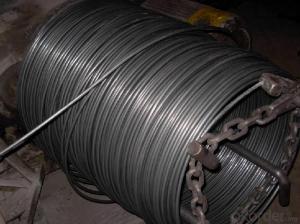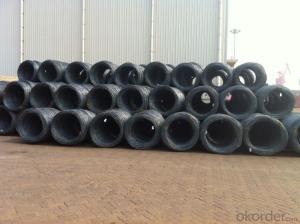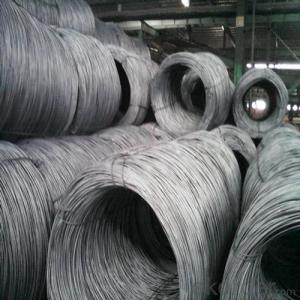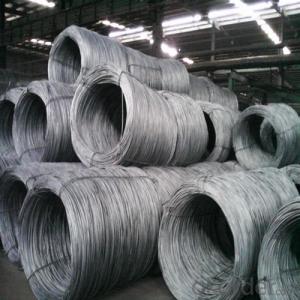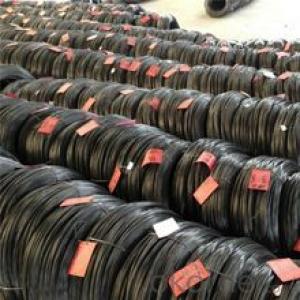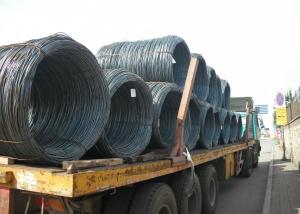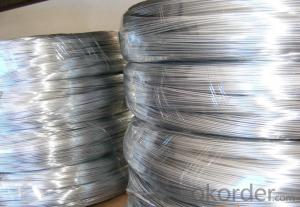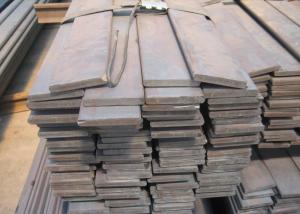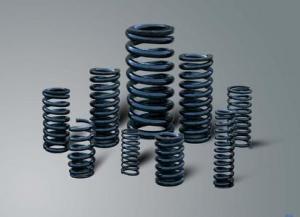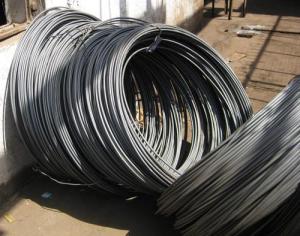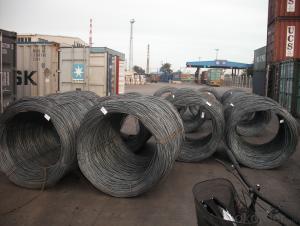WIRE ROD
- Loading Port:
- China Main Port
- Payment Terms:
- TT OR LC
- Min Order Qty:
- -
- Supply Capability:
- -
OKorder Service Pledge
OKorder Financial Service
You Might Also Like
Steel Grade: Q195 Standard: ASTM, GB
Diameter: 5.5mm, 6.5mm, 7mm,8mm,9mm,10mm,12mm,14mm
6.5mm can be drawing into 2mm/8.0mm can be drawing into 3mm
Type: Drawn Wire in Coil, each coil weight about 2MT
Brand Name: N-RIVER Place of Origin: Hebei, China
Chemical Composition:
Please kindly find our chemistry of our material based on Q195 as below for your information
Trademark | Rank | Chemical composition (quality score) % | | ||||
C | Si | Mn | S | P | | ||
| | |||||||
| ≤ |
| ≤ | ≤ | | ||
Q195 |
| 0.06-0.12 | 0.30 | 0.25 | 0.050 | 0.045 | |
Trademark | Rank | Pulling Test | | ||||
Bend PointΔs/Mpa | Tensile Strength | Elongation Ratioδ5% | | ||||
| | |||||||
Thickness (Diameter) /MM | Thickness (Diameter) /MM | | |||||
≤16 | 16-40 | | ≤16 | 16-40 | | ||
≥ | | ≥ | | ||||
Q195 |
| 195 | 185 | 315-390 | 33 | 32 | |
Usage and Applications of Wire Rod Q195:
After hot-rolled the products shaped into coil and delivery as finished product, including round, square, rectangular, hexagonal and so on. Since most of the products are round, it is generally called wire rod. Carbon steel wire rod is widely used in construction and manufacturing. Carbon steel wire rod is mainly used for reinforcement of reinforced concrete and welded structure or reprocessed (roberts , nail, etc.) materials, especially used to produce wire drawing, welding electrode, nails, spring, electronic, precise machinery parts and so on
- Q: What are the main distribution channels for steel wire rod?
- Steel wire rod is distributed through various channels including manufacturers, wholesalers, retailers, and e-commerce platforms. Manufacturers play a vital role by producing different grades and sizes of steel wire rod. They have their own distribution networks to directly supply the product to wholesalers or retailers. These manufacturers often have sales teams or agents who actively promote and sell their products to potential customers. Wholesalers act as intermediaries by purchasing large quantities of steel wire rod from manufacturers and then distributing it to retailers or other businesses. They have extensive networks and warehouses to efficiently store and transport the product. Wholesalers often offer competitive pricing and bulk discounts, making them an attractive option for retailers and businesses looking to buy steel wire rod in large quantities. Retailers are the final link in the distribution chain, selling steel wire rod directly to end consumers or small businesses. They can be specialized steel suppliers or hardware stores that carry a wide range of products. Retailers provide convenient access to steel wire rod for customers who require smaller quantities or immediate availability. The distribution of steel wire rod has been significantly impacted by the emergence of e-commerce platforms in recent years. Online marketplaces allow manufacturers, wholesalers, and retailers to reach a wider customer base and facilitate direct sales. E-commerce platforms provide convenience, quick delivery, and often offer competitive pricing, making them an increasingly popular choice for buyers. In summary, the main distribution channels for steel wire rod include manufacturers, wholesalers, retailers, and e-commerce platforms. This combination of traditional channels and the growing prominence of e-commerce platforms has transformed the industry.
- Q: What are the different types of steel wire rod surface cleaning processes?
- There are several different types of steel wire rod surface cleaning processes, including mechanical cleaning methods such as shot blasting and wire brushing, chemical cleaning methods like pickling and phosphating, and thermal cleaning methods such as flame or plasma cleaning. Each process has its own advantages and is used based on the specific requirements and desired outcome for the steel wire rod surface.
- Q: What are the common types of internal defects in steel wire rod?
- Some common types of internal defects in steel wire rod include inclusions, segregations, cracks, and voids. Inclusions are foreign substances that are trapped within the steel during the manufacturing process. Segregations occur when the composition of the steel is not uniform, resulting in areas with different properties. Cracks can occur due to excessive stress or improper cooling during production. Voids are empty spaces or cavities within the steel. These defects can weaken the wire rod and affect its overall quality and performance.
- Q: How is steel wire rod used in the manufacturing of wire for power transmission lines?
- The manufacturing process for wire used in power transmission lines relies heavily on steel wire rod. This essential component serves as the raw material for creating high-strength conductors that carry electrical energy across vast distances. To begin the manufacturing process, high-quality steel wire rods are carefully selected. These rods are typically made from either carbon steel or alloy steel. They then undergo a series of processes, including heating, rolling, and drawing, to transform them into wires with specific diameters and strengths. The primary role of the steel wire rod is to provide the necessary mechanical strength and conductivity required for power transmission lines. Steel is known for its exceptional tensile strength, which enables the wire to withstand the immense tension and stress experienced during installation and operation of transmission lines. Moreover, steel wire rod offers excellent electrical conductivity. This means that it allows electricity to flow efficiently through the wire, minimizing power loss and ensuring optimal transmission efficiency over long distances. The manufactured wire, which is made from steel wire rod, is typically stranded together to create a conductor. Multiple layers of these steel wire strands are then wound around a central core to form a composite conductor. This design enhances the wire's strength and flexibility, making it suitable for enduring extreme weather conditions, wind, and ice loads. Furthermore, steel wire rod plays a critical role in ensuring the durability and reliability of power transmission lines. Its corrosion resistance properties protect the wire from environmental factors such as moisture and chemical exposure, which could otherwise compromise the integrity of the line. To summarize, steel wire rod is essential in the manufacturing of wire for power transmission lines due to its exceptional tensile strength, electrical conductivity, and corrosion resistance properties. It enables the production of high-quality conductors that can efficiently transmit electrical energy over long distances while enduring various environmental challenges and ensuring uninterrupted power supply.
- Q: What are the common production processes for carbon-coated steel wire rod?
- The common production processes for carbon-coated steel wire rod typically involve cleaning the steel wire rod, applying a layer of carbon coating through various methods such as electroplating or chemical deposition, and then curing or drying the carbon coating to ensure its adhesion and durability.
- Q: How is steel wire rod used in the manufacturing of wire forms for fishing nets?
- Steel wire rod is a crucial component in the manufacturing of wire forms for fishing nets. The wire rod serves as the raw material from which the wire forms are created. Firstly, the steel wire rod is processed through a series of steps to transform it into a usable wire form. This includes cleaning, annealing, and drawing the wire rod to achieve the desired diameter and tensile strength. These processes ensure that the wire is strong and flexible enough to withstand the tension and stress it will experience when used in fishing nets. Once the wire rod is transformed into wire, it is then used to create the various wire forms required for fishing nets. These wire forms include various components such as hoops, rings, loops, and connectors that are essential for constructing a functional fishing net. The wire forms are created using specialized machinery and techniques, including bending, cutting, and welding the wire according to the specific design requirements. These wire forms are then assembled together to form the net structure. The use of steel wire rod in the manufacturing of wire forms for fishing nets provides numerous advantages. Steel is known for its high strength and durability, making it ideal for withstanding the harsh conditions and constant tension that fishing nets are subjected to. Additionally, steel wire rod is resistant to corrosion, ensuring that the wire forms will have a long lifespan even when exposed to water and other environmental factors. In conclusion, steel wire rod is a vital component in the manufacturing of wire forms for fishing nets. It serves as the raw material from which the wire forms are created, providing the necessary strength, flexibility, and durability required for a functional fishing net.
- Q: What are the different types of heat treatment processes for steel wire rod?
- Steel wire rod can undergo various heat treatment processes, each with its own advantages and effects on the material. 1. Annealing: By heating the steel wire rod to a specific temperature and slowly cooling it, annealing improves the material's ductility and toughness. This makes it easier to shape and form. 2. Quenching and tempering: The steel wire rod is heated to a high temperature and then rapidly cooled, or quenched, to increase its hardness and strength. It is then tempered by reheating it to a lower temperature to reduce brittleness and enhance toughness. 3. Normalizing: Similar to annealing, normalizing involves heating the steel wire rod to a specific temperature and cooling it in still air. This process refines the grain structure, enhancing strength and machinability. 4. Stress relieving: By heating the steel wire rod to a specific temperature and slowly cooling it, stress relieving reduces internal stresses caused by previous manufacturing processes. This improves dimensional stability and minimizes the risk of distortion during subsequent processing or use. 5. Case hardening: Also known as carburizing, this process introduces carbon into the surface layer of the steel wire rod to increase its hardness. It is achieved by heating the wire rod in a carbon-rich atmosphere. Case hardening creates a hard outer layer while maintaining a softer and more ductile core, providing a combination of wear resistance and toughness. Each heat treatment process can be customized to achieve specific material properties for the desired application. Factors such as desired hardness, strength, toughness, and machinability influence the choice of process for the steel wire rod.
- Q: What are the common applications of spring steel wire rod?
- Due to their unique properties and characteristics, spring steel wire rods are widely utilized in various industries. They have a multitude of applications, including but not limited to: 1. Springs: The manufacturing of springs heavily relies on spring steel wire rods. These rods provide the necessary elasticity and flexibility required for applications that involve constant or intermittent compression or extension. They are commonly used in automotive suspension systems, mattress springs, door locks, and industrial machinery. 2. Fasteners: Spring steel wire rods are commonly employed in the production of fasteners such as bolts, screws, and rivets. Their high tensile strength and resistance to deformation ensure that these fasteners can withstand significant stress and maintain their structural integrity. 3. Wire forms: The excellent formability of spring steel wire rods makes them suitable for the production of various wire forms, including hooks, clips, rings, and brackets. These wire forms find applications in industries such as construction, automotive, aerospace, and household appliances. 4. Musical instruments: The manufacturing of musical instruments, particularly piano strings and guitar strings, extensively utilizes spring steel wire rods. Their high tensile strength and elasticity result in strings that can produce clear and resonant tones. 5. Fencing and mesh: Spring steel wire rods are commonly employed in the production of fences, mesh screens, and wire grids. Their high strength and durability make them suitable for security fencing, animal enclosures, and industrial sieving applications. 6. Suspension systems: The automotive industry widely uses spring steel wire rods for manufacturing suspension systems. These rods provide the necessary flexibility and resilience to absorb shocks and vibrations, ensuring a smooth and comfortable ride. 7. Electrical conductors: In certain electrical applications, spring steel wire rods are occasionally utilized as conductors. Their high conductivity and ability to withstand high temperatures make them suitable for specific electrical wiring and heating elements. 8. Oil and gas industry: The oil and gas industry employs spring steel wire rods for various purposes, including downhole tools, wireline cables, and coiled tubing. Their high strength and resistance to corrosion make them suitable for demanding environments. In conclusion, spring steel wire rods are versatile and find applications in a wide range of industries due to their unique combination of strength, elasticity, formability, and resistance to deformation.
- Q: What are the safety precautions to be followed while working with steel wire rod?
- When working with steel wire rods, there are several safety precautions that should be followed: 1. Wear appropriate personal protective equipment (PPE) such as gloves, safety goggles, and protective clothing to protect against cuts, abrasions, and eye injuries. 2. Ensure that the work area is clean and free from any obstacles or clutter that may cause tripping or slipping hazards. 3. Use the correct tools and equipment for handling and cutting steel wire rods. Ensure that tools are in good condition and properly maintained. 4. Familiarize yourself with the proper handling techniques for steel wire rods. Avoid sharp or sudden movements that may cause the wire rod to whip or recoil. 5. Keep a safe distance from other workers to prevent accidental contact with the wire rod. 6. Store steel wire rods in a secure and stable manner to prevent them from rolling or falling. 7. Use caution when cutting or bending steel wire rods, as these actions can create sharp edges or flying debris. Always cut away from your body and use appropriate cutting tools. 8. Be aware of the weight and length of the wire rod you are handling, as they can be heavy and difficult to control. Avoid overexertion and seek assistance if needed. 9. Follow proper lifting techniques when moving or transporting steel wire rods. Bend your knees, keep your back straight, and use your leg muscles to lift and carry the rods. 10. In case of any injury or accident, seek immediate medical attention and report the incident to your supervisor. It is important to always prioritize safety when working with steel wire rods, as they can pose various hazards if not handled properly.
- Q: What are the main factors affecting the price of steel wire rod?
- Several main factors influence the price of steel wire rod. Firstly, the cost of raw materials used in the production of steel wire rod, primarily iron ore and scrap metal, plays a significant role in determining its price. Fluctuations in the prices of these raw materials can directly impact the price of steel wire rod. Secondly, the price of energy, particularly electricity and fuel, greatly affects the cost of manufacturing steel wire rod. Changes in energy prices, such as fluctuations in oil prices or government policies on carbon emissions, can impact the overall price of the product. The supply and demand dynamics in the market also influence the price of steel wire rod. If the demand for steel wire rod increases while the supply remains constant, prices are likely to rise. Conversely, excess supply compared to demand can result in lower prices. Market competition among steel wire rod manufacturers can impact its price. In a highly competitive market, manufacturers may lower their prices to attract customers, leading to a decrease in the overall price of the product. Conversely, limited competition can result in higher prices. International trade and tariffs on steel wire rod can affect its price. Trade policies, such as import restrictions or tariffs imposed by governments, can limit supply or increase costs. Fluctuations in currency exchange rates can impact the price of steel wire rod. If the currency in which steel wire rod is priced strengthens against other currencies, it may lead to an increase in its price. Technological advancements in the production of steel wire rod can influence its price. Newer technologies may result in higher efficiency, reducing production costs and potentially lowering the price of the product. In summary, the price of steel wire rod is influenced by factors such as raw material costs, energy costs, supply and demand dynamics, market competition, international trade and tariffs, currency exchange rates, and technological advancements. It is crucial to monitor these factors to understand and predict fluctuations in the price of steel wire rod.
Send your message to us
WIRE ROD
- Loading Port:
- China Main Port
- Payment Terms:
- TT OR LC
- Min Order Qty:
- -
- Supply Capability:
- -
OKorder Service Pledge
OKorder Financial Service
Similar products
Hot products
Hot Searches
Related keywords
